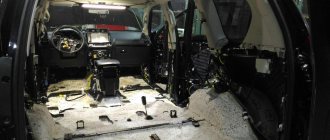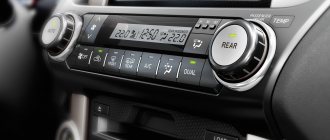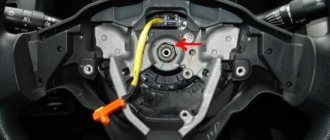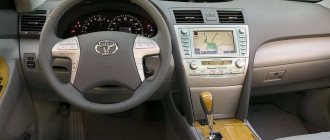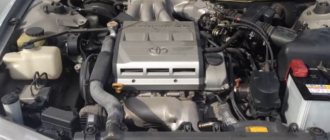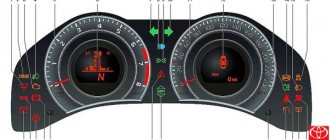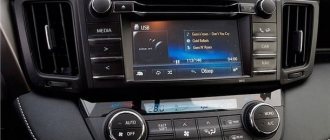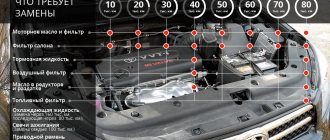The dashboard of each car is designed to provide the driver with all the necessary information about the state of the vehicle at the time of its movement. This allows you to control your ride and notice any kind of malfunction in time. The Toyota Camry 40 instrument panel displays indicators such as:
- the distance traveled by the car (both overall and in the current session);
- current movement speed;
- fuel tank full;
- battery health, etc.
Maintaining the panel elements in working order is critically important, since the analysis of the information received helps prevent more serious vehicle breakdowns and ensures safe driving.
Camry V40 dashboard malfunctions, causes
Inscription on the computer screen CHECK VSC SYSTEM As wear occurs, malfunctions can appear in any element of the car. The instrument panel is no exception. From time to time, owners encounter various types of malfunctions in the operation of the instrument panel of their Toyota Camry XV40. Despite the diversity in the consequences of breakdowns, they have similar causes. Depending on which element has failed, the reasons can be divided into main groups:
- a non-working car on-board computer screen will not be able to display any breakdowns in the electronics;
- electrical wiring malfunctions are a serious problem that can lead to the impossibility of timely informing the driver about the serviceability of the Camry 40’s key operating systems (anti-lock braking, traction control and others);
- indicator lamps that are not lit will cause a lack of information about the headlights being turned on, the battery charge level, or the side lights being turned on;
- a burnout of the Toyota Camry dashboard board is easier to notice, since a frequent consequence of this is the switching off of the box backlight and the indicators operating from it;
- breakdown of dial gauges may result from improper functioning of the tachometer, speedometer, coolant thermometer or fuel level indicator in the tank.
Steering wheel and dashboard of Camry 50 and 55 If, during the start of the Camry 40, the serviceability of the dashboard is in doubt, you should immediately find out and eliminate the causes of the problems either yourself (if you have the necessary experience) or at the nearest service station.
Packaging with a hint of sport
In the seventh pre-restyling version, the panel was distinguished by its rigor and utmost information content, and did not have bright accents - a godsend for conservative middle-aged business people. The backlighting of the controls stood out in blue, which was gaining popularity. The Toyota Camry control panel the edited detail to the corporation's marketers - they tried to separate the hybrid versions from the base models using blue backlighting.
As an example: the upper dashboard belongs to the 50th version of the Camry, the lower one belongs to the updated one.
The manufacturer decided to take a fair risk by including youth parts in the updated model that were unusual for the model’s buyer segment. Along with the technical innovations of the 2014 restyling, an experimental element was the board of controls and controls, which turned out to be frankly sporty. And, forgetting that green remains the signature color of the environmentally friendly corporation, the Camry dashboard now greets the driver with blue backlighting.
Interpretation of icons on the instrument panel
For a driver to better understand the situation on the road, he must understand the meaning of each indicator. The diagram below will help you learn them. Description of the icons located on the Camry V40 dashboard:
- Indicator of the current coolant temperature.
- Door opening control.
- Indicator that the seat belt is fastened.
- Side light activity indicator.
- A tachometer showing the speed of the crankshaft in a car engine with an accuracy of 100 revolutions per minute. 6) Indicator of the current position of the automatic transmission selector.
- Indicates whether the left turn signal is on at this moment.
- Indicator for using distant lighting.
- Shows whether the right turn signal is on at this moment.
- Speedometer showing the current speed of the vehicle.
- On-board computer screen showing electronic errors if they occur.
- Indicator for turning on the front fog lights.
- Indicator for turning on the rear fog lights.
- Fuel tank fill level indicator.
- Operating condition of the electronic component of Toyota engine management.
- An indicator of a critically low fuel level in the tank, indicating the need for refueling.
- Anti-slip status indicator.
- Restarts the calculation of the distance covered by the car in the current race.
- Dynamic stabilization performance indicator.
- Monitoring of airbags, head restraints, belt tensioners and other elements of the passive safety system.
- Performance and charge level of the acid battery.
- Indicator of the operating state of the Toyota Camry 40 headlight luminous flux control.
Measuring and indicating instruments
The control panel has a complex structure, but if you analyze it correctly, you can be convinced of its simplicity:
- Tachometer - for measuring the speed of the unit.
- Speedometer - determines the current speed limit, dial - on the right, upper corner.
- The odometer records the total mileage of the car, displaying the data in a special field.
- Antifreeze temperature meter mounted in the right area of the option combination.
- Fuel consumption indicators are located in the left area. If the arrow tends downward, it is exaggerated.
- The regulator, which is responsible for the direction of the axes, plays an important role in the overall design of the machine mechanism.
- High beam and hazard warning lights (its switch) make the machine easy to operate.
In some cases, it may be necessary to replace the dashboard; to solve this problem, you need to consult with specialists and entrust the work to real professionals.
Absolutely every shield and every icon are the most important elements in any device, and before disassembling them, it’s worth knowing the intricacies of the entire v20 mechanism and other model attributes.
Removing the dashboard
Camry 40 dashboard board If you have the necessary experience and knowledge, troubleshooting the operation of the “tidy” and replacing components can be done independently. To do this, it is necessary to dismantle the panel. This is not difficult to do, you just need to follow the instructions.
Before starting work, check the serial number of the instrument panel for compliance with the software component and the pinout for connecting electronics. For Asia, Europe and America, Toyota produces different ones. Dismantling algorithm:
1) There are false panels attached below the dashboard, which are removed first. 2) The lower part of the shield is held on by two screws. Unscrew them.
3) After this, unscrew the screws located on top of the shield. 4) Remove the trim that performs decorative functions.
5) Disconnect the shield connector. 6) Remove the dashboard.
Camry steering wheel and dashboard 55 on top and 70 on bottom.
Unscrupulous sellers of used Toyota cars often dismantle the Camry “tidy” to change the odometer readings. Therefore, twisted bolts of the shield fastenings are a reason to doubt the odometer readings. Please take this into account when making a transaction.
Reporting a malfunction
The battery icon lights up if the voltage in the on-board network drops; often this problem is associated with a lack of battery charge from the generator, so it can also be called the “alternator icon”. On vehicles with a hybrid engine, this indicator is supplemented by the inscription “MAIN” at the bottom.
The oil icon , also known as a red oil can, indicates a drop in the oil level in the car engine. This icon lights up when you start the engine, and does not go out after a few seconds or may light up while driving. This fact indicates problems in the lubrication system or a drop in oil level or pressure. The oil icon on the panel may have a droplet or waves at the bottom; on some cars the indicator is supplemented with the inscription min, senso, oil level (yellow inscriptions) or simply the letters L and H (characterizing low and high oil levels).
The airbag icon can light up in several ways: either the red inscription SRS and AIRBAG, or “a red man wearing a seat belt,” with a circle in front of him. When one of these airbag icons lights up on the panel, the on-board computer notifies you of a malfunction in the passive safety system, and in the event of an accident, the airbags will not deploy. Read the article on the website for the reasons why the airbag sign lights up and how to fix the problem.
The exclamation mark icon may look different and its meaning will accordingly be different. So, for example, when the red (!) light is on in the circle, this indicates a malfunction of the brake system and it is advisable not to continue driving until the cause of its occurrence is determined. They can be very different: the handbrake is up, the brake pads are worn out, or the brake fluid level has dropped. A low level is precisely what poses a danger, because the reason may not only be in heavily worn pads, as a result of which, when you press the pedal, the fluid disperses throughout the system, and the float gives a signal about a low level, the brake hose may be damaged somewhere, and this is much more serious. Although, very often the exclamation mark lights up if the float (level sensor) is faulty or shorted, and then it simply lies. On some cars, the exclamation mark is accompanied by the words “BRAKE”, but this does not change the essence of the problem.
An exclamation mark can also light up in the form of an “attention” sign, both on a red and yellow background. When the yellow “attention” sign lights up, it informs about a malfunction in the electronic stabilization system, and if it is on a red background, it simply warns the driver about something, and, as a rule, explanatory text is displayed on the dashboard display or combined with other informative text designation.
The ABS icon may have several display options on the dashboard, but regardless of this, it means the same thing on all cars - a problem has occurred in the ABS system, and that the anti-lock wheel system is not working at the moment. You can find out the reasons why ABS does not work in our article. In this case, movement can be made, but there is no need to rely on the ABS to activate; the brakes will operate as usual.
The ESP icon may either light up intermittently or stay on constantly. A light with this inscription indicates problems with the stabilization system. The Electronic Stability Program indicator, as a rule, lights up for one of two reasons - either the rotation angle sensor has failed, or the brake light sensor (aka “frog”) has died for a long time. Although, there can be a more serious problem, for example, the brake system pressure sensor is covered.
The engine icon , some drivers may call it the “injector icon” or check, may glow yellow when the engine is running. It informs about the presence of engine errors and malfunctions of its electronic systems. To determine the reason for its appearance on the dashboard display, self-diagnosis or computer diagnostics are performed.
The glow plug icon may light up on the dashboard of a diesel car; the meaning of such an indicator is exactly the same as the “check” icon on gasoline cars. When there are no errors in the electronic unit’s memory, the spiral icon should go out after the engine warms up and the glow plugs are turned off. Read how to check glow plugs here.
This material is informative for most car owners. And although absolutely all possible icons of all existing cars are not presented here, you will be able to independently understand the main symbols of the car’s dashboard, and will not sound the alarm when you see that the icon on the panel is on again.
Sequence of actions to eliminate engine errors
At the first stage of error elimination, before diagnostics, you can carry out the following work (with the ignition off, preferably with the battery terminal removed):
- check all fuses serving the engine control unit for integrity and quality of contacts;
- carry out an external inspection of the main relay and the fuel pump relay, move them a little;
- tighten the contacts and connectors of the sensors, flow meter, throttle valve, and other electronic devices located on the engine;
- check the external integrity of the electrical wiring under the hood.
Such simple actions often help in situations where an error message appears after a short stop (the check light did not light up in the evening, but appeared in the morning after starting). When parked, especially in humid and cold climates, corrosion processes intensify as the engine cools, causing contacts and conductors to lose their electrical properties. The connections are broken and an error is introduced into the circuit. To avoid such cases, before the cold period of vehicle operation, it is recommended to treat harnesses, contacts, connectors with special compounds (you can use regular silicone grease in the form of a spray - it pushes out moisture).
If, after connecting the battery terminal and turning on the ignition, the error message appears again, it is necessary to perform computer diagnostics.
